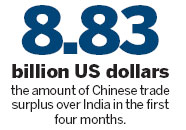Sino-Indian trade imbalance to increase
Updated: 2013-05-21 08:16
By Li Jiabao (China Daily)
|
||||||||
|
Indian businessmen talk about orders at a footwear exposition in Jinjiang, Fujian province, in April. Lin Shanchuan / Xinhua |

The trade imbalance between China and India is likely to keep growing and the situation is hard to change, but India is benefiting from Chinese imports, experts said.
"India's trade deficit with China is expanding. In the short term, that's hard to resolve. The imbalance is mainly because India has limited exports to China, while Chinese manufactured goods have a competitive advantage in the Indian market," said Liu Xiaoxue, a researcher on South Asian studies at the Chinese Academy of Social Sciences.
The slower growth pace in China in recent years, together with overcapacity in the steel and iron sectors and the Chinese government's tightening policies in the real estate sector, reduced demand for Indian raw materials - mainly iron ore and iron sand, which account for the bulk of Indian exports to China. That's the reason behind the country's increasing trade deficit with China, Liu added.
Hu Shisheng, director of the Institute of South and Southeast Asian and Oceanian Studies at the China Institutes of Contemporary International Relations, agreed with Liu's view.
"The trade imbalance is rooted in India's trade structure," Hu said.
"India's trade deficit with China will not be reversed in the foreseeable future. Any change depends on whether India can export products that meet the demand of the Chinese market," Hu added. "In fact, the trade deficit is likely to increase because India needs more Chinese manufactured products, and China diversified its sources for imports of raw material."
In the first four months of the year, Sino-Indian trade declined 6.2 percent year-on-year. Chinese exports increased 3.6 percent and imports decreased 24 percent, yielding a trade surplus of $8.83 billion, according to China's General Administration of Customs.
In 2012, bilateral trade dropped 10.1 percent, and China's exports went down 5.7 percent while its imports plunged 19.6 percent, leaving a trade surplus of $28.87 billion, compared with $27.17 billion in 2011 and $20.08 billion in 2010, according to customs data.
"India has trade deficits with major manufacturing countries due to the depreciation of the rupee in recent years, its poor export advantages and robust import demand, especially for mechanical equipment, amid its economic transformation. But the trade deficit with China is remarkable," Hu said.
The expanding trade deficit with China, which accounts for one-third of India's overall trade deficit, has been a concern for India for many years and partially accounts for the frequent trade remedy investigations it launches into imports of Chinese products, experts said.
"Trade probes from India will remain frequent in the coming years as India's imports of low-end manufactured products from China dent its efforts to revive its manufacturing sector," Liu said. "But trade investigations should be resolved under the World Trade Organization framework."
Hu added that India's trade deficit with China is "no big deal and far from a safety concern".
"India should seize this period when Chinese exports have good quality and low prices, as prices of Chinese exports are rising. Expanding imports from China just benefits India because they lower its costs of economic transformation, enhance the living standard of its citizens and increase its exports to markets such as the United States and the European Union," Hu said.
Wang Shouwen, director of the Foreign Trade Department of the Ministry of Commerce, said on May 9 that the Chinese and Indian economies are highly complementary and that bilateral trade has huge potential.
"In the future, the importance of Sino-Indian trade will be equal to that between the US and the EU," Wang said.
lijiabao@chinadaily.com.cn
(China Daily 05/21/2013 page3)

 Michelle lays roses at site along Berlin Wall
Michelle lays roses at site along Berlin Wall
 Historic space lecture in Tiangong-1 commences
Historic space lecture in Tiangong-1 commences
 'Sopranos' Star James Gandolfini dead at 51
'Sopranos' Star James Gandolfini dead at 51
 UN: Number of refugees hits 18-year high
UN: Number of refugees hits 18-year high
 Slide: Jet exercises from aircraft carrier
Slide: Jet exercises from aircraft carrier
 Talks establish fishery hotline
Talks establish fishery hotline
 Foreign buyers eye Chinese drones
Foreign buyers eye Chinese drones
 UN chief hails China's peacekeepers
UN chief hails China's peacekeepers
Most Viewed
Editor's Picks

|

|

|

|

|

|
Today's Top News
Shenzhou X astronaut gives lecture today
US told to reassess duties on Chinese paper
Chinese seek greater share of satellite market
Russia rejects Obama's nuke cut proposal
US immigration bill sees Senate breakthrough
Brazilian cities revoke fare hikes
Moody's warns on China's local govt debt
Air quality in major cities drops in May
US Weekly

|

|








